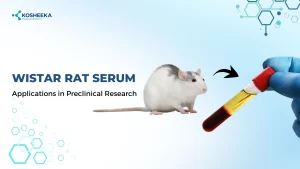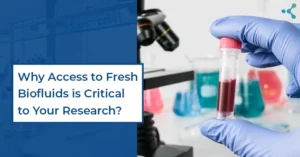At Kosheeka. We provide freshly isolated, well-characterized, ready-to-use Human peripheral blood mononuclear cells (PBMCs). PBMCs play a crucial role in human immune system. PBMCs have a single circular nucleus. PBMCs are major immune cells, including T cells ~ 70%, B cells ~15%, monocytes ~ 5%, dendritic cells ~ 1%, and natural killer (NK) cells ~ 10%. The T cell co-receptor (CD3+ expressing T lymphocytes) can be categorized into CD4+ and CD8+ cytotoxic cells. PBMCs are also critical in toxicity studies of new drug, as it get exposed to chemicals.
Human PBMCs have multiple applications in toxicology research:
- Novel drug toxicity assessment: Drug which are toxic to PBMCs, causes immune suppression and toxicity of immune system. PBMCs are a tool to predict safe drug dosage.
- Side-by-Side comparative studies: Diseased and Healthy PBMCs are used to study molecular pathways of drug responses.
- Environmental Toxicity: PBMCs are tool to study environmental exposure of heavy chemicals or other environmental pollutants which affects immune system.
- Chemotherapeutic Toxicity: Cancer patients’ PBMCs exhibit significant toxicity after chemotherapy as compared to healthy individuals. Even distinct variation in drug toxicity observed in old and young cancer patients.
This type of toxicity profiling is performed by a combination of systems biology and bioinformatics, using multi-omics datasets and biomarkers. Human PBMCs composed of multiple inflammatory cells, are readily available and cost-effective source to study immune system and provide an insights of circulating serum/plasma biomarkers. Following are few “omics” and systems-based approaches applied to PBMCs.
- Transcriptomics: Transcriptional signature of PBMCs from diseased and healthy individuals utilizing RNA-Seq and microarray analyses, exhibit differential gene expression patterns and putative biomarkers of various diseases e.g. cancer, HIV, COPD, autoimmune diseases etc.
- Epigenomics: The emergence of the next-generation sequencing of bisulfite converted DNA give assess to study biological processes involved human diseases. Epigenetics plays a crucial role in regulation of gene expression and inheritance.
- Proteomics: Human PBMCs are used to study immune-related biomarkers associated with specific pathophysiology.
- Metabolomics: Metabolic profiling of PBMCs of diseased or healthy humans are used to identify metabolic markers in various pathological conditions. Cell metabolites are extracted non-invasively and analysed by Mass spectroscopy. Metabolomics also give insights of dietary intakes and physiological status.

Let’s explore intriguing applications for Kosheeka’ ready-to-use PBMCs in other research areas:
- Regenerative Therapy: PBMCs contribute to functional recovery by promoting angiogenesis, tissue repair and preservation of cellular functions. PBMCs can differentiate into various cell types e.g. Hematopoietic stem cells (HSCs), mesenchymal stem cells (MSCs), and endothelial progenitor cells (EPCs) etc. Scientists have successfully reprogrammed PBMCs into induced pluripotent stem cells (iPSCs), further expanding their therapeutic applications.
- Drug Discovery: Leveraging induced pluripotent stem cell (iPSC) technology, diseased or healthy individuals’ PBMCs can be reprogrammed to iPSCs. This provides a platform to generate virtually all cell types that can recapitulate patient-specific responses, such as hepatocytes, neurons, cardiomyocytes, endothelial cells, etc. This method gives researchers the ability to evaluate drug toxicity in a physiologically relevant conditions, test for novel therapeutics, and modelling disease mechanisms. This also supports personalized treatment strategies and predictive accuracy leading to the creation of novel drugs.

- Transplantation of Autologous PBMCs: Compared to bone marrow stem cells, PBMCs can be extracted non-invasively. By using autologous PBMC transplantation, ethical issues and long-term immunosuppressive therapies are avoided. Haematological cancers can be treated with PBMC transplantation.
- Diagnosing Autoimmune Diseases: Various autoimmune diseases are characterized by activation and distribution of different types of immune cells. PBMCs are a powerful tool for studying immune biomarkers in autoimmune diseases. PBMCs are easily accessible (non-invasive) and gives status of pathogenic factors present in blood.
- Off-the-shelf CAR-T therapy: A novel technique to immunotherapy known as CAR-T cell therapy involves genetically modifying a patient’s T cells to produce the chimeric antigen receptor (CAR). These T cells have been altered to fight against cancer cells because they are made to detect particular antigens on tumor cells without the aid of major histocompatibility complexes (MHCs). One of the major challenges in autologous i.e. patient derived CAR T therapy is its delayed treatment availability and inconsistent product quality. In cancer patients T cell dysfunction and exhaustion is widely reported, leading to limited efficacy. PBMCs sourced from patient or healthy donors, are normally the source of the T cells employed in CAR-T therapy. Utilizing PBMCs from healthy donors allows CAR-T cells to be created “off-the-shelf” for multiple patients, reducing the time and cost of development as compared to customized cell therapies. This strategy is a viable way to expedite process and increase accessibility to CAR-T therapy. Allogenic CAR T cell therapy is suitable to treat highly aggressive T cell malignancies, as its not contaminated with malignant T cells. Life-threatening graft-versus-host disease (GvHD), self-killing of CAR t cells are come of the limitations of allogenic CAR T therapy. These challenges can be overcome by addition genetic modifications. For example, deletion of CD7 expression in healthy donor’s T cells prevents self-killing of CAR T cells. To address host immune cell rejection, genetically modified human leukocyte antigen (HLA) class II expression in CAR T cells is reported. Further investigations are required to make off the shelf CAR T therapy safe, efficacious and universally available.

- Prognostic and Diagnostic Biomarkers: In recent studies, PBMCs have been identified as a potential source of biomarker. Variations in mRNAs/micro RNAs signature and methylation profile patterns in PBMCs can indicate the state of many diseases, such as metabolic disorders linked to nutrition and chronic diseases like lateral sclerosis and arthritis. PBMCs mimic in vivo microenvironment of some tissues which are in contact with them like cancerous cells, hence providing a non-invasive and suitable source of biomarkers. Biomarker based diagnostic is well established today in clinical setting, but capabilities of prognostic biomarkers are still in nascent phase. Prognostic biomarkers are beneficial as it predicts diseases before it happens, can also determine its severity and progression.
- Development of Next-Generation PBMC Humanized Mice: Cancer is one of the most lethal diseases worldwide. The therapeutic landscape of cancer has expanded from surgery, radiation and chemotherapy, to immunotherapy, which includes adoptive cell transfer, gene therapy and modulation of immunosuppression. Safety, efficacy and mechanism of immune-oncology agents are generally studied in preclinical mouse models but interspecies immunity differences are reducing off-target effects. Human PBMC-engrafted immune-deficient mice are ideal for short-term studies of HIV infections, immune-oncology and graft-versus-host diseases which requires mature T cells. PBMC humanized mice are cost effective, easy to develop and clinically relevant model. PBMC humanized mice express human-like immune system. This is a time effective process as the mature immune cells in PBMCs take only 7-10 days for engraftment in mice. PBMC humanised model are developed by injecting gradient-isolated human PBMCs via intrasplenic, intraperitoneal, or intravenous route into recipient animals. 5×106−2×107 PBMCs per recipient mouse are used, less than this number of PBMCs causes functional differences.




